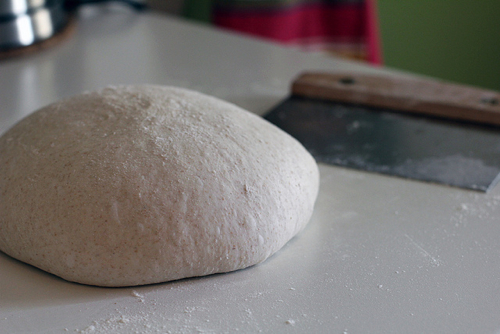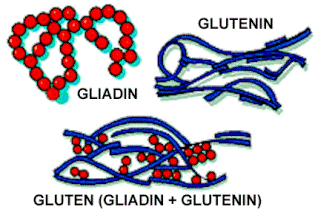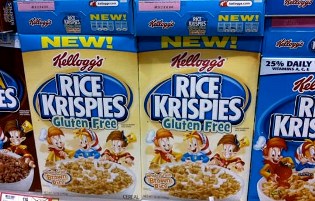Food Studies features the voices of volunteer student bloggers from a variety of different food- and agriculture-related programs at universities around the world. You can explore the full series here.
 Gluten is what makes bread dought elastic enough to risePhoto: Three Points KitchenIt’s clear that Americans have an obsession with gluten. Just begin typing the word into a search engine and “gluten-free” pops up immediately, followed by “gluten-free diet.” The next most popular term is “gluten-free beer.” So it seems the obsession with gluten is really about removing it from our diets.
Gluten is what makes bread dought elastic enough to risePhoto: Three Points KitchenIt’s clear that Americans have an obsession with gluten. Just begin typing the word into a search engine and “gluten-free” pops up immediately, followed by “gluten-free diet.” The next most popular term is “gluten-free beer.” So it seems the obsession with gluten is really about removing it from our diets.
Make no mistake, celiac disease and gluten intolerance are very serious problems and pose real dietary constraints. Considering the number of foods that contain wheat, rye, and barely, removing gluten from processed foods is very challenging. Recently, because of the growing prevalence of these forms of intolerance, the food industry has been working fiercely to develop gluten-free products to both meet the demand and optimize sales in response to a gluten-free trending market.
And it’s true; the general public does now seem more aware of gluten, and many appear to be buying gluten-free products, regardless of their dietary constraints. But from a scientific perspective, it strikes me that most people probably don’t even know what gluten is, or how it functions in our food.
 Let’s begin with gluten’s chemical composition; it is actually a complex protein created when gliadin and glutenin — two proteins found in several flours — are hydrated and mixed. In the bread-making process, for instance, water is added to flour, where it hydrates proteins, causing them to swell and become stretchy and flexible. Kneading this mixture rearranges the proteins into what is called a “gluten complex.” As any bread aficionado knows, to make a good bread, the dough must be elastic enough to relax when it rests and expand and hold air when it rises — while still maintaining its shape. Gluten makes this behavior possible.
Let’s begin with gluten’s chemical composition; it is actually a complex protein created when gliadin and glutenin — two proteins found in several flours — are hydrated and mixed. In the bread-making process, for instance, water is added to flour, where it hydrates proteins, causing them to swell and become stretchy and flexible. Kneading this mixture rearranges the proteins into what is called a “gluten complex.” As any bread aficionado knows, to make a good bread, the dough must be elastic enough to relax when it rests and expand and hold air when it rises — while still maintaining its shape. Gluten makes this behavior possible.
And while wheat flour has high and nearly equal levels of gliadin and glutenin — those gluten building blocks I mentioned earlier — flours made from other grains that have insufficient amounts (or an imbalance in one or the other) will cause a limit to the structural matrix that can be formed in the final food product. Corn flour, for example, has high amounts of gliadin but low amounts of glutenin, rye has low amounts of glutenin, and oats have a very low amount of gliadin. This is also why gluten-free bread is so challenging to make and rarely tastes good.
 What many consumers don’t realize, however, is that there are many naturally occurring gluten-free foods that have been newly labeled as such, just to take advantage of the gluten-free trend. Anything made exclusively of rice flour (a grain which contains no gluten) for example — like mochi, rice noodles, or dumpling wrappers — has always been gluten free! The same goes for milk, chocolate, and potato chips.
What many consumers don’t realize, however, is that there are many naturally occurring gluten-free foods that have been newly labeled as such, just to take advantage of the gluten-free trend. Anything made exclusively of rice flour (a grain which contains no gluten) for example — like mochi, rice noodles, or dumpling wrappers — has always been gluten free! The same goes for milk, chocolate, and potato chips.
Of course, there are also exceptions. You may have seen the new-gluten free Rice Krispies, for instance. Those came out this summer, and the new label is actually a legitimate claim. The original Rice Krispies recipe, despite being based on rice, does actually contain gluten in the form of barley malt. And there are likely other examples.
For people with gluten sensitivity, these products are a necessity and will hopefully get better over time, as food scientists continue to make new breakthroughs (making bread without gluten is no easy task). But I think those of us who can eat gluten should appreciate what it does to our breads, pizza crusts, and bagels. After all, gluten isn’t evil, it’s just protein!




